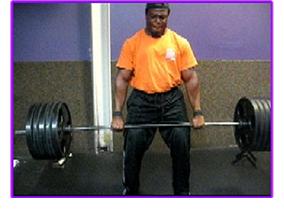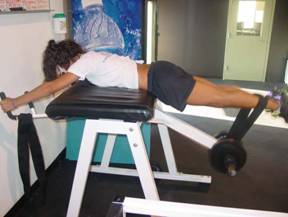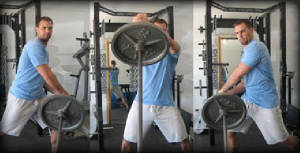|
Sciatica is a problem that affects a lot of people on a day to day basis. Not only is it painful but
can become quite problematic when trying to live life on a day to day basis. Now imagine try to be a fitness competitor, bodybuilder,
or power lifter suffering from sciatica. Let’s just say this can cause your training programs to be less than optimal.
What if you could learn a way to not only help with your sciatica but also improve your training program?
What is sciatica?
Sciatica is generally caused when lumbar nerves in the spine are compressed. The Sciatic nerve is the
longest nerve in your entire body. It runs down your spinal cord to your butt and hip area, serves the muscles of the hamstrings,
and down the back of your legs. The big misconception is sciatica is not the disorder but actually a problem signal. This
is important because depending on the actual problem is how you would treat the type of sciatica. The pain from sciatica is
the signal to another problem involving the nerve, such as a herniated disk. Symptoms can range from days, to weeks, to months
Symptoms:
Burning or stinging pain that travels down the path of the Sciatic nerve and its off shooting branches.
Numbness
muscle weakness
pins and needles
tingling
Sometimes trouble moving the particular leg.
Possible Spinal Disorders:
Like stated earlier sciatica is often misrepresented as a problem and actually what it is, a signal
for another problem. Here are some of the possible problems sciatica could be alerting you to.
- Herniated Disk-This happens when one of the discs in your spine begins pressing on one of the roots of the sciatic nerve.
These discs are comprised of a spongy material that has a liquid in the center. When the liquid center bulges outward it tears
the fiberous material that holds it in and intrudes in the spinal canal where nerve is and puts pressure on the nerve.
- Spinal Stenosis-This happens when the spinal canal (the space where the spinal canal runs) narrows and compresses the
spinal cord and sciatic nerve roots.
- Piriformis syndrome- In a small percent of the population the sciatic nerve runs under the piriformis muscle. The piriformis
muscle is an almost pear shaped muscle that lies parallel with one of the glute muscles (gluteus medius to be exact). This
muscle helps with lateral rotation of the hips. When this muscle irritates the sciatic nerve in the gluteal area, it causes
a real pain in the ass "literally".
- Poor Posture- This is one of the most common causes of sciatica. Walking hunched over, sitting slouched all day, or sleeping
in unnatural positions apply a lot of unnecessary pressure on the spine compressing the root of the sciatic nerve.
- Pregnancy- This happens when the uterus begins pressing on the sciatic nerve. It can also happen from compression on the
spine from carrying extra weight of the fetus and change in posture.
So now that we know a little more about what sciatica is, the question is are there any preventative
measures we can take or things we can do to help with sciatica. The answer is yes. All you have to do is learn two simple
words….POSTERIOR CHAIN.
What is the posterior chain?
The posterior chain is a group of muscles, tendons, and ligaments on the posterior kenetic chain of
the body. In other words those muscles, ligaments, and tendons that run up and down the backside of your body. Just think
of your hamstrings, glute muscles, spinal erectors, lats, traps, and calves for example.
The posterior chain and sciatica:
While you may not think so, exercise is much better than bed rest for relieving sciatica. A day or two
may be alright after a flare up but usually any more inactivity will make sciatica worse. Less exercise means less conditioned
muscles and spinal column. Exercise is good because it moves blood and spinal fluids in and out of the spinal disc. Okay so
what does working your posterior chain have to do with helping with or preventing Sciatica? It does two main things in particular.
1. It increases mobility and flexibility and 2. It builds tremendous strength in those posterior muscles. Now considering
sciatica can be an indication of weak or herniated disk in the back, compressed spine from being weak or inflexible, weak
glutes leading to sciatica symptoms, or weak or non mobile muscles leading to poor posturing, it only makes sense to learn
to develop the posterior chain.
Okay so now what exercises should we do to develop the posterior chain when dealing with sciatica? Well
developing the posterior chain this way is slightly different than a normal person trying to develop their posterior chain.
Someone trying to develop the posterior chain this way should focus more on muscle balance and flexibility. A "normal" person
generally is just looking for overall development of their posterior chain.
Deadlifts:
Well if we need to develop the posterior chain, what exercise is best for developing the posterior chain?
That is an easy answer. Dead lift without a question is the answer. No exercises will do more for your posterior chain on
a whole. Dead lifts work all the muscles in the posterior chain in a big way. Dead lifting hits your traps, rear delts, lats,
spinal erectors, glutes, hams, and hips in a big way. For someone who does not dead lift regularly, a few weeks of medium
weight medium rep deadlifts will do wonders for your posterior chain.

Why not squats?
Well squats are another whole body big exercise, what about them. Contrary to belief squats are not
one of the best exercises for building the posterior chain. You need a strong posterior chain to squat big but a big squat
does not necessarily give you a strong posterior chain. Most people who have a large squat number have usually built it through
exercises that help strengthen of the posterior chain. Heavy squatting alone over time actually compresses the spine and can
sometimes aggravate sciatica. Another factor to think about is some people have trouble squatting with proper form due mostly
to underdeveloped posterior chains.

It’s a little more complicated than that:
So it seems deadlifts are the best overall one exercise for developing the posterior chain. In that
case, let’s just do a bunch of deadlifts and be done with things….right?
Well not in the case of dealing with sciatica and the posterior chain. Remember sciatica is not a problem
but a signal to a problem. This means not everyone that has sciatica has the same problem. So while deadlifts may work for
some, it may do nothing for others. While developing the posterior chain is still going to be one of the best things you can
do depending on your problem should be how you focus on your posterior chain.
Good Preventative Exercises:
Next we are going to look at five exercises that can be very good preventative exercises and or good
rehab exercises for the posterior chain. If you already suffer from sciatica make sure you have a good stretching program
that you can implement with these exercises. Stretching is one of the best things you can do to relieve sciatica. Next time
around we will look at some stretches that can be beneficial for sciatica. There are also weightless alternate versions of
the exercises described here. The weightless versions are not intended for building muscle but more for therapeutic stretching
people can do until they work up to using weights. Now here are the five:
- The Good Morning
- The Glute Kickback
- The Reverse Hyperextention
- The Adductor/Abductor
- The Barbell Landmine Twist
The Good Morning:
The good morning is a real winner when it comes to strengthening the posterior chain. This is a very
good exercise that usually ends up getting a very bad rap. You always hear things like
"The Good morning is a risky exercise that places too much stress on the spinal erectors and is a recipe
for trouble!"
Here is a question you may not know the answer to. What are two of the strongest muscle groups in the
body besides the tongue? Give up? They are the glutes and the spinal erectors. The good morning is and exercise that that
places major focus on both these muscle groups. The problem most people run into with Good Mornings is people are not used
to this exercise and usually their major muscles for the Good Morning are underdeveloped. Top that off with people trying
to use too much weight with bad form and you have a recipe for disaster. When done correctly however you can use the good
morning to develop a very strong set of erectors and glute muscles.
One reason this is important because strong spinal erectors cut down on compression of lower back muscles
when you place heavy weight on your back from things like squatting. Less spinal compression means less chance of things like
compressed or herniated disc in the back. A second important reason is stronger glutes mean less of a workload the hamstrings
and lower back has to take. The glute muscles are not only some of the strongest muscles in the body but also act as stabilizers
for the hips, hamstrings, knees, pelvis and lower back. When the glutes are weak or do not work properly the load is moved
more towards the lower back resulting in a tremendous load being placed on the lower back. Over time this can lead to sciatica
symptoms of a bigger problem.
The Glute Kickback Machine aka Butt Blaster:
"The Butt Blaster? Seriously? I can’t do that, I’m a dude."
Well if you want to strengthen the posterior chain and help with hip flexibility I suggest you put your
male ego aside for a bit. This is a great exercise especially if your sciatica is coming from Piriformis syndrome. The Glute
kickback machine not only helps stretch and strengthens the glutes but also helps improve hip flexibility. The movement of
Glute Kickback Machine also mimics the one of the stretch actions that is good for Piriformis syndrome. By pulling your hips
forward towards your chest and pushing backwards and out your stretching the area of the glutes that sometimes irritate the
piriformis muscle.
The Reverse Hyperextension:
The Reverse Hyperextension machine is a machine that you do not see in a lot of gyms. That is a shame
because the reverse hyperextension is one of the best exercises that can be done for the posterior chain. The reverse hyper
is so beneficial because it’s main targets are the lower back, glutes, hamstrings, and to a lesser degree the abs. Anyone
who has done a hyperextension exercise, knows the benefits it brings the lower back. Due to the reverse movement of the reverse
hyper it brings those benefits and even more fore the hamstrings and glutes. The movement of the reverse hyperextension allows
the spinal column to rehab by allowing fluid in and allowing blood into the lower back. It also removes pressure from your
spinal disc by doing this. This is beneficial because a lot of sciatica cases result from extra pressure or compression in
the back. This is a great exercise to perform after a round of heavy squatting. If your lower back is ever hurting after a
few sets of heavy squats, end your leg routine with some reverse hypers and see how much better your back will feel. The reverse
hyper is also a great developer of the ham and glutes. Although primarily looked at as a rehab exercise the reverse hyperextension
can also be a great strength and muscle builder. The key to having a great glute and ham workout with hyper extensions is
to squeeze your glutes and hams on the lifting portion of the exercise. Remember strong hams and glutes not only take off
pressure on the back but also help in hip flexibility, two related problems when sciatica symptoms occur.

The Adductor/Abductor machine:
The adductor/abductor machine is another great exercise for the posterior chain. The adductor/abductor
machine targets the inner and outer hip muscles. The hip muscles are important to the posterior chain because the hips and
glutes help control pelvic rotation. The stronger and more flexible your hips are the more upright you will stand. If your
hips happen to be weak or underdeveloped it will cause your pelvis to rotate forward causing you to have a forward lean. Over
time this forward lean can put unnecessary stress on the back leading to herniated disc or back strains. Not only is the adductor/abductor
machine excellent for improving hip flexibility but also great for stretching and building glute muscles. Hip adduction is
especially good for stretching the piriformis muscle. Hip adduction actually increases the stretch on the sciatic nerve. The
more flexible your sciatic nerve is the less chance of it being tight and causing pain. A word of caution though, the adductor/abductor
is a great preventive exercise. If you are already suffering from sciatica symptoms from Piriformis syndrome you may want
to be careful with this one. If your piriformis muscle is bound and tight from inflexibility, trying to overstretch it with
adduction movements will sometimes only irritate your situation even more. Be sure to use weight you can manage and a stretch
position that stretches you but does not irritate you.
Barbell Landmine Twist:
Okay you got me! This one bends the rules a little because it’s actually an abdominal exercise.
So technically speaking this is more of an anterior chain rotation exercise but don’t think it doesn’t do wonders
for the posterior chain.
This anti-rotation exercise not only conditions the whole body but also builds the obliques and upper
glutes. By building and strengthening the obliques, barbell landmines help support the spinal erectors by giving extra support
muscles. Barbell landmines also increase hip flexibility by increasing hip rotation. The thing to make sure of is not to twist
at the spine but to pivot the feet. You also want to make sure you focus on hip rotation when you do them. By building more
stabilizer muscles you take the pressure off of your back building a more solid all around midsection. Because landmines also
strengthen the glutes, they will also improve all around posterior chain strength by taking pressure off of the back, hips,
and hamstrings muscles.

Linking up the chain:
Since most cases of sciatica symptoms occur due to problems related to the back,
glutes, or hips it would be in your best interest to start strengthening your posterior chain. The posterior chain is the
muscles, tendons, and ligaments directly related to the backside of the body. Not only will developing the posterior chain
make you bigger, faster, and stronger but will also cut down on injury related problems such as sciatica. The stronger and
more flexible these muscle, tendons, and ligaments are the less chance of sciatica related problems.
"The more you build your backside the less things will be a pain in the ass!"
*Disclaimer- This information in this article is not meant to treat, diagnose, prescribe or cure
any ailment. Always consult a physician before you begin any new exercise program, start, stop, or change anything that has
been previously prescribed...
|

